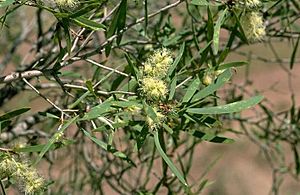Fibre-barked teatree facts for kids
Quick facts for kids Fibre-barked teatree |
|
|---|---|
 |
|
| Scientific classification | |
| Genus: |
Melaleuca
|
| Species: |
stenostachya
|
The fibre-barked teatree or straight teatree (scientific name: Melaleuca stenostachya) is a plant from the myrtle family. You can find it growing in northern Australia, especially in the Cape York Peninsula and the gulf areas of the Northern Territory. It also grows in the southern parts of Papua New Guinea.
This plant is quite similar to another species called Melaleuca dealbata. However, you can tell them apart because the flowers of the fibre-barked teatree are spread out more widely along their flower spikes.
What It Looks Like
The fibre-barked teatree can be a large bush or a small tree. It can grow up to about 15 metres (49 feet) tall. Its bark is white to dark grey and feels like paper or fibres.
Its leaves grow one after another along the stem. They are usually 25 to 120 millimetres (1 to 5 inches) long and 2 to 16 millimetres (0.1 to 0.6 inches) wide. The leaves are long and narrow, or sometimes oval-shaped. They feel silky because they are covered with fine hairs, and they come to a sharp point. Each leaf also has 5 to 7 lines running along its length.
Flowers and Fruit
The flowers of the fibre-barked teatree are creamy-white. They grow in spikes at the ends of the branches. These branches keep growing even after the plant flowers. Sometimes, flowers also appear where the upper leaves join the stem.
Each flower spike has 6 to 12 groups of flowers, with three flowers in each group. These groups are spaced out well along the spike, which can be up to 18 millimetres (0.7 inches) wide. Inside each flower, there are five groups of stamens (the parts that make pollen). Each group has 6 to 10 stamens.
This plant can flower almost any time of the year. After the flowers, small, woody seed pods (called capsules) grow. These pods are about 2 to 3 millimetres (0.08 to 0.12 inches) long.
Naming the Plant
The scientific name Melaleuca stenostachya was first officially described in 1968 by a scientist named Stanley Thatcher Blake.
The second part of its name, stenostachya, comes from two Ancient Greek words. "Stenos" means "narrow" or "tight," and "stachys" means "a spike" or "an ear of grain." This name refers to the plant's narrow flower spikes.
Where It Grows
You can find the fibre-barked teatree in the Borroloola area of the Northern Territory, across the Cape York Peninsula, and in southern parts of Papua New Guinea. It likes to grow in places that flood during certain seasons, like swamps, and along the banks of creeks. It can grow in different types of soil.



